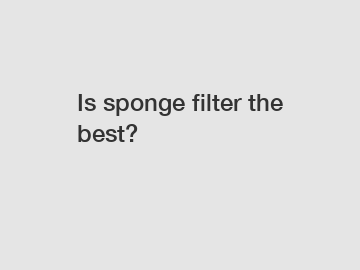Is sponge filter the best?
Sponge filters have been a popular choice among aquarium enthusiasts for many years, but are they truly the best option for your tank? In this blog post, we'll explore the benefits and drawbacks of using a sponge filter, as well as alternative filter options to consider for your aquarium.
First and foremost, sponge filters are highly recommended for use in tanks with small fish or fry. The fine sponge material helps to prevent baby fish from being sucked into the filter, which can be a common issue with more traditional filter types. Additionally, the gentle flow of water through the sponge filter is ideal for delicate aquatic creatures, as it provides a less stressful environment compared to other types of filters with stronger water flow.
Another advantage of sponge filters is their simplicity and ease of maintenance. They are incredibly easy to set up and require minimal effort to clean and maintain. Simply remove the sponge from the filter, rinse it in tank water, and replace it back in the filter – it's that easy! This makes sponge filters a great choice for beginner hobbyists or those who want a low-maintenance filtration system for their tank.

In terms of cost, sponge filters are also budget-friendly options compared to other types of filters on the market. They are typically inexpensive to purchase and require minimal ongoing costs for replacement parts. This makes them an attractive choice for hobbyists who might be working within a tighter budget or simply want to save money on their aquarium setup.
However, there are some drawbacks to consider when using a sponge filter in your tank. One of the main disadvantages is the limited filtration capacity of sponge filters compared to other types of filters, such as canister filters or hang-on-back filters. Sponge filters are best suited for smaller tanks or tanks with low bioloads, as they may struggle to keep up with the filtration needs of larger tanks or tanks with more fish.
Additionally, sponge filters can be less aesthetically pleasing than other types of filters, as they typically need to be placed inside the aquarium where they can be seen. This may not be ideal for aquarists who want a clean and sleek look for their tank, as the sponge filter can disrupt the visual appeal of the aquarium setup.
If you're considering using a sponge filter in your tank, it's important to also consider alternative filter options that may better suit your needs. For larger tanks or tanks with higher bioloads, canister filters or hang-on-back filters may be better choices, as they have greater filtration capacity and can handle the demands of a more heavily stocked tank.
Ultimately, whether or not a sponge filter is the best option for your tank depends on your individual preferences and the specific requirements of your aquarium setup. If you have a small tank with delicate fish or fry, a sponge filter may be the perfect choice for you. However, if you have a larger tank with a higher bioload, you may want to explore other filter options that can better meet the filtration needs of your tank.
In conclusion, while sponge filters have their advantages, they may not be the best option for every aquarium setup. Consider the size of your tank, the type of fish you keep, and your aesthetic preferences when choosing a filter for your tank. And remember, no matter which filter you choose, regular maintenance and water changes are key to keeping your aquarium healthy and thriving.
Want more information on galvanized steel water storage tanks, smc panel water tank, pvc vs polypropylene? Feel free to contact us.



